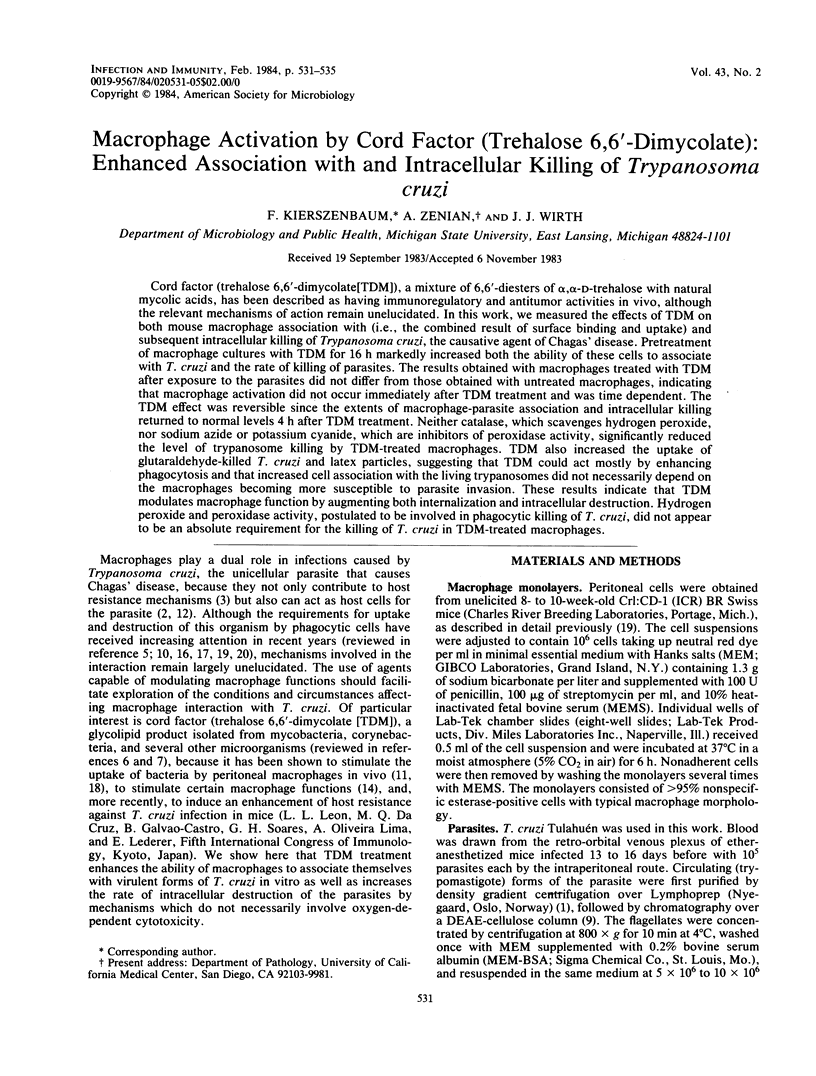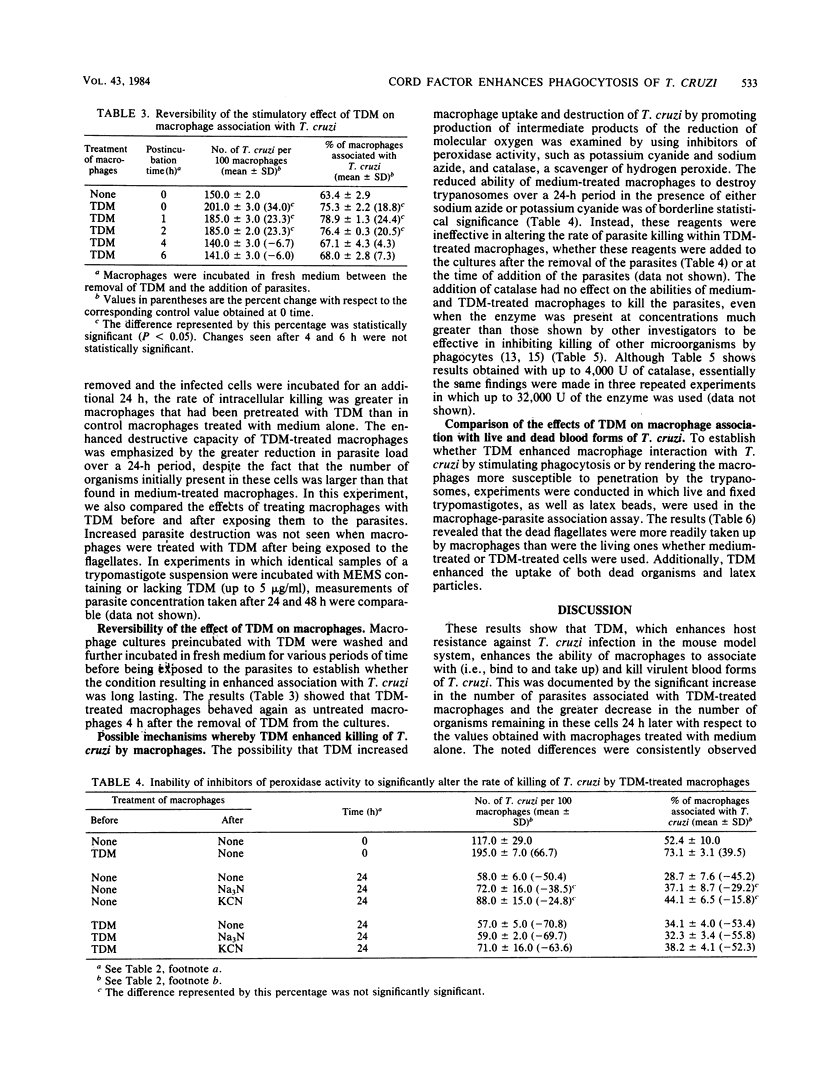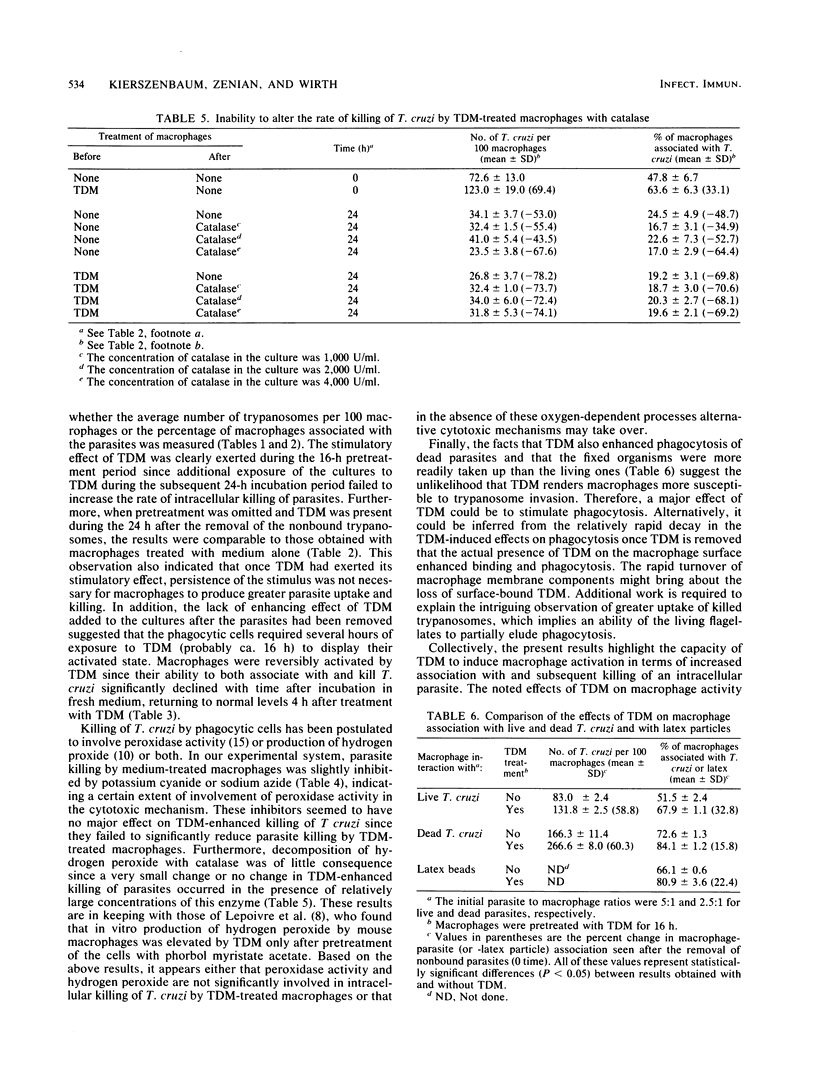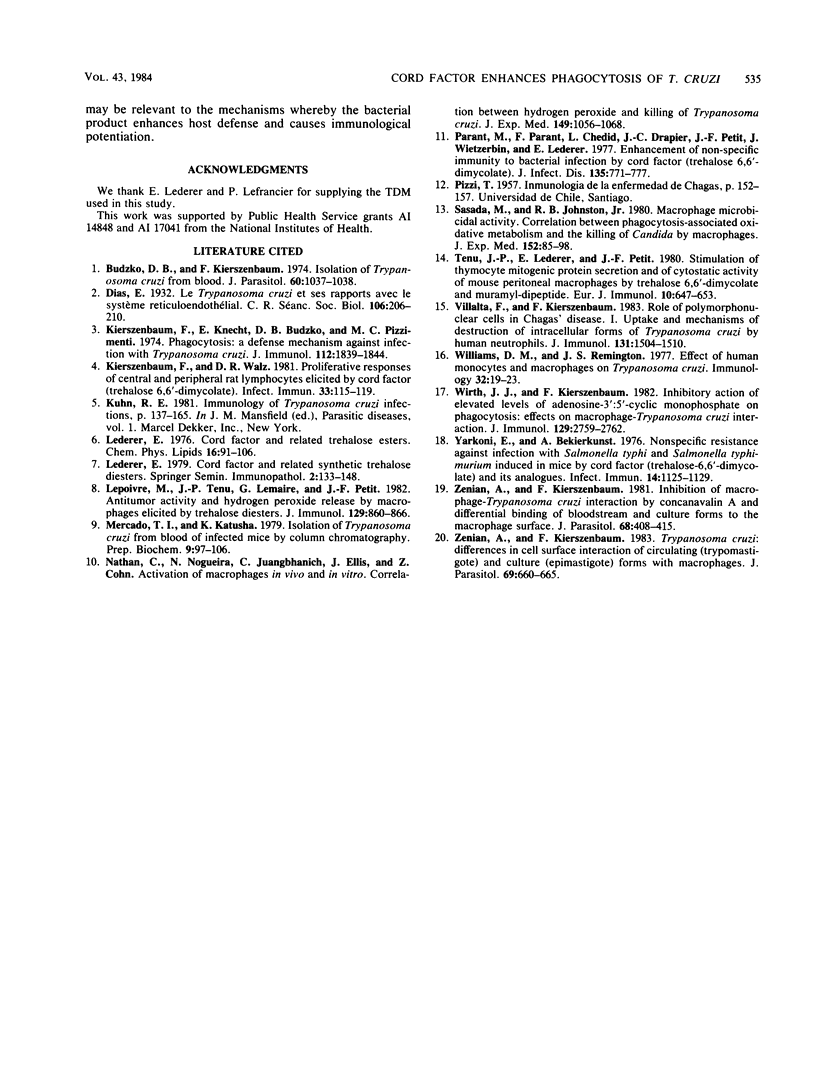Abstract
Cord factor (trehalose 6,6'-dimycolate[TDM] ), a mixture of 6,6'-diesters of alpha, alpha-D-trehalose with natural mycolic acids, has been described as having immunoregulatory and antitumor activities in vivo, although the relevant mechanisms of action remain unelucidated. In this work, we measured the effects of TDM on both mouse macrophage association with (i.e., the combined result of surface binding and uptake) and subsequent intracellular killing of Trypanosoma cruzi, the causative agent of Chagas' disease. Pretreatment of macrophage cultures with TDM for 16 h markedly increased both the ability of these cells to associate with T. cruzi and the rate of killing of parasites. The results obtained with macrophages treated with TDM after exposure to the parasites did not differ from those obtained with untreated macrophages, indicating that macrophage activation did not occur immediately after TDM treatment and was time dependent. The TDM effect was reversible since the extents of macrophage-parasite association and intracellular killing returned to normal levels 4 h after TDM treatment. Neither catalase, which scavenges hydrogen peroxide, nor sodium azide or potassium cyanide, which are inhibitors of peroxidase activity, significantly reduced the level of trypanosome killing by TDM-treated macrophages. TDM also increased the uptake of glutaraldehyde-killed T. cruzi and latex particles, suggesting that TDM could act mostly by enhancing phagocytosis and that increased cell association with the living trypanosomes did not necessarily depend on the macrophages becoming more susceptible to parasite invasion. These results indicate that TDM modulates macrophage function by augmenting both internalization and intracellular destruction. Hydrogen peroxide and peroxidase activity, postulated to be involved in phagocytic killing of T. cruzi, did not appear to be an absolute requirement for the killing of T. cruzi in TDM-treated macrophages.
Full text
PDF




Selected References
These references are in PubMed. This may not be the complete list of references from this article.
- Budzko D. B., Kierszenbaum F. Isolation of Trypanosoma cruzi from blood. J Parasitol. 1974 Dec;60(6):1037–1038. [PubMed] [Google Scholar]
- Kierszenbaum F., Knecht E., Budzko D. B., Pizzimenti M. C. Phagocytosis: a defense mechanism against infection with Trypanosoma cruzi. J Immunol. 1974 May;112(5):1839–1844. [PubMed] [Google Scholar]
- Kierszenbaum F., Walz D. R. Proliferative responses of central and peripheral rat lymphocytes elicited by cord factor (trehalose 6,6'-dimycolate). Infect Immun. 1981 Jul;33(1):115–119. doi: 10.1128/iai.33.1.115-119.1981. [DOI] [PMC free article] [PubMed] [Google Scholar]
- Lederer E. Cord factor and related trehalose esters. Chem Phys Lipids. 1976 Mar;16(2):91–106. doi: 10.1016/0009-3084(76)90001-3. [DOI] [PubMed] [Google Scholar]
- Lepoivre M., Tenu J. P., Lemaire G., Petit J. F. Antitumor activity and hydrogen peroxide release by macrophages elicited by trehalose diesters. J Immunol. 1982 Aug;129(2):860–866. [PubMed] [Google Scholar]
- Mercado T. I., Katusha K. Isolation of Trypanosoma cruzi from the blood of infected mice by column chromatography. Prep Biochem. 1979;9(1):97–106. doi: 10.1080/00327487908061675. [DOI] [PubMed] [Google Scholar]
- Parant M., Parant F., Chedid L., Drapier J. C., Petit J. F., Wietzerbin J., Lederer Enhancement of nonspecific immunity to bacterial infection by cord factor (6,6'-trehalose dimycolate). J Infect Dis. 1977 May;135(5):771–777. doi: 10.1093/infdis/135.5.771. [DOI] [PubMed] [Google Scholar]
- Sasada M., Johnston R. B., Jr Macrophage microbicidal activity. Correlation between phagocytosis-associated oxidative metabolism and the killing of Candida by macrophages. J Exp Med. 1980 Jul 1;152(1):85–98. doi: 10.1084/jem.152.1.85. [DOI] [PMC free article] [PubMed] [Google Scholar]
- Tenu J. P., Lederer E., Petit J. F. Stimulation of thymocyte mitogenic protein secretion and of cytostatic activity of mouse peritoneal macrophages by trehalose dimycolate and muramyldipeptide. Eur J Immunol. 1980 Aug;10(8):647–653. doi: 10.1002/eji.1830100813. [DOI] [PubMed] [Google Scholar]
- Villalta F., Kierszenbaum F. Role of polymorphonuclear cells in Chagas' disease. I. Uptake and mechanisms of destruction of intracellular (amastigote) forms of Trypanosoma cruzi by human neutrophils. J Immunol. 1983 Sep;131(3):1504–1510. [PubMed] [Google Scholar]
- Williams D. M., Remington J. S. Effect of human monocytes and macrophages on Trypanosoma cruzi. Immunology. 1977 Jan;32(1):19–23. [PMC free article] [PubMed] [Google Scholar]
- Wirth J. J., Kierszenbaum F. Inhibitory action of elevated levels of adenosine-3':5' cyclic monophosphate on phagocytosis: effects on macrophage-Trypanosoma cruzi interaction. J Immunol. 1982 Dec;129(6):2759–2762. [PubMed] [Google Scholar]
- Yarkoni E., Bekierkunst A. Nonspecific resistance against infection with Salmonella typhi and Salmonella typhimurium induced in mice by cord factor (trehalose-6,6'-dimycolate) and its analogues. Infect Immun. 1976 Nov;14(5):1125–1129. doi: 10.1128/iai.14.5.1125-1129.1976. [DOI] [PMC free article] [PubMed] [Google Scholar]
- Zenian A., Kierszenbaum F. Inhibition of macrophage-Trypanosoma cruzi interaction by concanavalin A and differential binding of bloodstream and culture forms to the macrophage surface. J Parasitol. 1982 Jun;68(3):408–415. [PubMed] [Google Scholar]
- Zenian A., Kierszenbaum F. Trypanosoma cruzi: differences in cell surface interaction of circulating (trypomastigote) and culture (epimastigote) forms with macrophages. J Parasitol. 1983 Aug;69(4):660–665. [PubMed] [Google Scholar]


